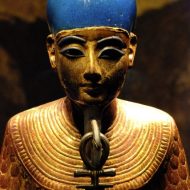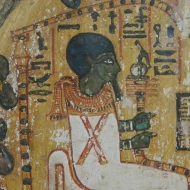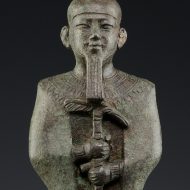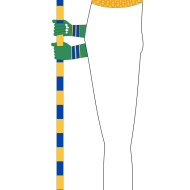Ptah : God of Craftsmen
Listen
At a glance
| Description | |
|---|---|
| Origin | Egyptian Mythology |
| Classification | Gods |
| Family Members | Sekhmet (Wife), Nefertem (Son) |
| Region | Egypt |
| Associated With | Craftsmanship, Creation |
Ptah
Introduction
Ptah is a prominent deity in Egyptian mythology, revered as the god of craftsmen and architects. His significance lies in his role as a creator deity believed to have brought the world into existence through the power of his speech. Ptah is part of the Memphite Triad, along with Sekhmet, his consort representing destruction and healing, and their son Nefertum, symbolizing beauty and fragrance. This triad embodies fundamental aspects of Egyptian cosmology, reflecting creation, destruction, and regeneration within the cosmic order.
Depicted in art as a mummified figure with distinctive regalia including a skullcap and scepter of dominion, Ptah’s visual representation emphasizes his authority over creation and earthly manifestation. Initially a local deity of Memphis, the ancient capital of Lower Egypt, Ptah’s cult expanded in prominence due to Memphis’s political importance during the 1st dynasty. Ptah’s association with craftsmanship extended beyond sculptors, making him a patron of artisans and a symbol of divine creativity.
Ptah’s influence transcends regional boundaries, as evidenced by his merging with other deities like Sokar and Osiris to form Ptah-Seker-Osiris, emphasizing transformation and resurrection. Nefertum and Sekhmet further underscore Ptah’s role within the Memphite Kingdom, highlighting his connection to both creation and destruction in the eternal cycle of life. Within Ptah’s temple in Memphis, the sacred bull Apis was venerated as a manifestation of Ptah, embodying divine oracular powers and enhancing Ptah’s mystical influence throughout ancient Egypt.
Physical Traits
Ptah’s representation in Egyptian art is distinctive and imbued with symbolism. Typically depicted as a mummified man with a clean-shaven head, Ptah’s form is enveloped in a tight-fitting garment that emphasizes his role as a cosmic craftsman and creator of life. The skullcap, known as the “atef” crown, adorning Ptah’s head signifies his authority and regal presence within the pantheon. Unlike many other gods characterized by anthropomorphic features, Ptah’s iconography focuses primarily on his creative attributes, highlighting his significance as a deity associated with craftsmanship and divine creation.
Statues of Ptah often portray him holding a staff, symbolizing his authority and creative power over the universe. Additionally, Ptah may be depicted with objects emblematic of craftsmanship, such as a chisel or a mallet, further accentuating his role as a patron of artisans and architects. Notably, during the New Kingdom period, Ptah’s depictions sometimes include a benevolent smile, suggesting wisdom and a nurturing demeanor aligned with his role as a creator god. Ptah’s unique visual representation, with his green skin symbolizing life and rebirth, underscores his association with cosmic order and the eternal cycle of creation.
Ptah’s imagery evolved over time, with variations in his portrayal reflecting different aspects of his divine nature. In some representations, Ptah is depicted as a dwarf, diverging from conventional depictions of Egyptian deities. His attire, typically a shroud adhering closely to his body, symbolizes his association with the mysteries of creation and regeneration. Holding a scepter combining symbols of life, stability, and dominion, Ptah’s divine beard and straight posture embody his role as a creator and sustainer of the cosmos. Ptah’s popularity surged during the Late Period, solidifying his status as a revered deity embodying the creative forces that underpin Egyptian religious beliefs and rituals.
Family
Ptah’s position within the divine family of Egyptian mythology is central and complex. He is commonly identified as the husband of Sekhmet, the formidable lioness-headed goddess associated with war and healing, and the father of Nefertum, the youthful god symbolizing beauty and fragrance through the lotus flower. These familial relationships highlight Ptah’s significance in the cosmic order, intertwining creation, destruction, and regeneration within the eternal cycle of life and death. Additionally, Ptah is sometimes credited as the father of Imhotep, a renowned figure revered for his wisdom and healing prowess.
The union of Ptah and Sekhmet represents a balance between creation and destruction, reflecting essential concepts in Egyptian cosmology. Their son, Nefertum, embodies the rejuvenation of life and nature, symbolized by the lotus flower—an emblem of beauty and rebirth in ancient Egyptian beliefs. Ptah’s family ties extend beyond Sekhmet and Nefertum, intertwining with other deities associated with creative or crafting attributes, such as Ptah-Sokar-Osiris, a tripartite deity merging creation, funerary rites, and the underworld, solidifying Ptah’s dominion over the cosmic cycle from inception to culmination.
Ptah’s origin is shrouded in mythological ambiguity. Some creation narratives depict him as self-created, emerging from the primordial mound—a representation of the cosmic beginning. Alternatively, other myths position Ptah as the offspring of the sky goddess Nut and the earth god Geb, situating him within the broader context of the Egyptian pantheon. This dual nature underscores Ptah’s role as a primeval force behind existence and the embodiment of divine craftsmanship and creative power.
Other names
Ptah’s significance in ancient Egyptian religion is reflected in a rich tapestry of epithets that highlight his multifaceted nature and diverse roles within the pantheon. Known as the “begetter of the first beginning,” “lord of truth,” “master of ceremonies,” “king of eternity,” “king of justice,” “God who made himself God,” “double being,” and “beautiful face,” Ptah’s epithets encapsulate various aspects of his divine authority and creative prowess. These titles underscore Ptah’s importance as a foundational deity revered for his role in creation, justice, and the eternal cycle of life and death.
In Memphis, the epicenter of Ptah’s cult, he was also worshipped under the composite identity of “Ptah-Sokar-Osiris,” merging attributes of Ptah with those of Sokar, the falcon god of the necropolis, and Osiris, the god of the afterlife and resurrection. This fusion of identities symbolizes Ptah’s transformative powers, bridging the realms of life and death, creation, and regeneration. It reinforces Ptah’s central role in Egyptian cosmology as a deity of profound significance, encompassing the cycles of existence and the mysteries of rebirth.
Among his epithets, Ptah is revered as the “Great Craftsman” (Ptah-wer-maat), emphasizing his divine artistry in shaping the universe and all its manifestations. Additionally, Ptah is hailed as the “Foremost of Sculptors” (Ptah-imy-wepet), highlighting his mastery in the arts of sculpting and creation. Titles such as “Lord of Truth” (Ptah-djed-ankh) underscore Ptah’s association with Ma’at, the cosmic order and balance essential to Egyptian theology. Lastly, the epithet “The Hidden One” (Ptah-sekhem-wi) alludes to Ptah’s enigmatic origins and underlying essence as a primordial force behind creation, adding depth to his mystical persona within the ancient Egyptian worldview.
Powers and Abilities
Ptah, the chief deity of Memphis, stands as a titan of creation in Egyptian mythology. As the divine artisan, he breathed life into the universe through the sheer power of his words. Ancient texts depict him uttering the names of all existence, solidifying his role as the architect of cosmic order and the source of all manifestation.
This creative force extended beyond the physical realm. Ptah was revered for his boundless wisdom, embodying the inherent creative potential that permeates the universe. He served as the patron of not only creation itself, but also the skilled hands that shaped it. Craftsmen, architects, and all those who molded physical matter fell under his domain.
Egyptians believed Ptah wielded the divine word, the “logos,” to will existence into being. Songs from various dynasties depict him crafting the world through both his heart and his tongue, emphasizing the potent magic imbued in his pronouncements. This connection to the spoken word further granted Ptah dominion over magic and healing. He was seen as the font of all knowledge, capable of weaving spells to restore health and bring order to chaos. As protector of the Pharaoh, Ptah ensured the continuation of Ma’at, the cosmic order, through the rightful rule of the king.
Modern Day Influence
Ptah, the enigmatic creator god of Memphis, stands as a towering figure even in the face of time. Egyptians believed him to be the architect of reality, breathing life into the universe through his spoken word. This power of creation extended beyond the physical realm, as Ptah was also revered for his boundless wisdom, inspiring not only creation itself but the skilled hands that brought those ideas to life. His association with craftsmanship and the divine word continues to resonate with modern artisans and thinkers, finding echoes in various art forms and sparking the imagination of those who contemplate the mysteries of existence.
Ptah’s legacy extends beyond the halls of museums and dusty tombs. The concept of a single creator god at the heart of everything finds parallels in many modern religions, a testament to the enduring power of this ancient belief system. Furthermore, popular culture embraces Ptah’s enigmatic persona. From the thrilling boss battles in Assassin’s Creed Origins to the whimsical portrayal in Futurama, Ptah continues to capture the imagination, inspiring artists, writers, and game developers to reimagine him for new audiences. These varied portrayals showcase the enduring fascination with Ptah, ensuring his place as a timeless figure in the grand narrative of human imagination.
Related Images
Frequently Asked Questions
What is Ptah the god of?
Ptah, the enigmatic Egyptian god, reigns supreme as the creator of all, the patron of skilled hands, and a symbol of cosmic order.
Who is Ptah married to?
What is Ptah power?
Who is the creator god of Egypt?
Ptah, the enigmatic Memphite god, stands as a creator supreme. He breathed life into the cosmos through his divine word, the “logos.” Beyond physical creation, his wisdom inspired artisans and fueled human ingenuity. His power encompassed shaping reality, wielding healing magic, and embodying the source of all knowledge.
What is Ptah's symbol?
While lacking a single iconic symbol, Ptah’s presence is marked by whispers of creation. The Djed pillar, a symbol of stability, hints at his role. The sacred bull embodies his essence, while crafting tools like chisels or the Was scepter held in his hand solidify his patronage of artisans.













